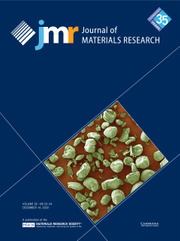Article contents
Scanning electron microscopy observations of misfit dislocations in epitaxial In0.25Ga0.75As on GaAs(001)
Published online by Cambridge University Press: 31 January 2011
Abstract
Dislocations in the misfit epitaxial film system In0.25Ga0.75As on GaAs(001) were imaged using a modified electron channeling contrast technique in a LaB6 SEM. We obtained images at an incident beam energy of 30 keV, a beam divergence of less than 1 mrad and a specimen tilt of 70° in conjunction with a movable scintillator detector mounted at a takeoff angle of approximately 3° to 5°. We achieved a spatial resolution of approximately 80 to 100 nm with this technique. Such resolution allowed rapid imaging of clusters consisting of only a few closely spaced dislocations in a 55 nm thick film. At such small film thicknesses, we did not require accurate knowledge of the incident beam direction in order to obtain sufficiently strong channeling contrast for qualitative characterization. The observed defect arrangements included features that we believe represent clustered threading segments.
Information
- Type
- Articles
- Information
- Copyright
- Copyright © Materials Research Society 1996
References
REFERENCES
- 1
- Cited by

